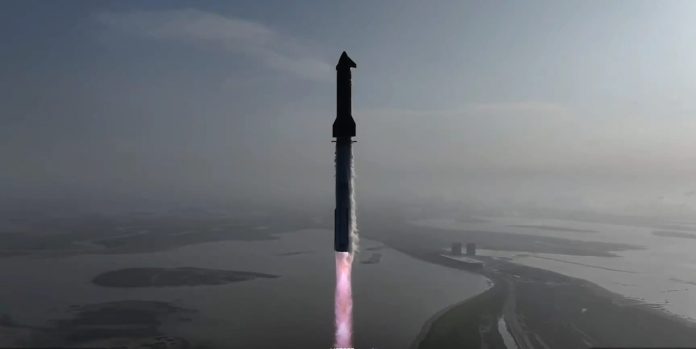SpaceX announced that its Starship vehicle experienced attitude control failure during a test flight Thursday, marking the third consecutive unsuccessful mission for the spacecraft program.
The vehicle lifted off from SpaceX’s Starbase facility in Texas at 7:36 p.m. Eastern on Flight 9. Launch preparations faced a brief delay when ground equipment experienced issues with a quick-disconnect fitting, requiring a countdown reset to T-40 seconds for several minutes.
The mission aimed to overcome engine failures that plagued the previous two test flights in January and March. All six Raptor engines operated normally during the six-and-a-half-minute burn, shutting down as planned after placing Starship on its intended suborbital trajectory.
Video footage immediately after engine shutdown showed the vehicle venting propellants and entering a slow roll.
SpaceX confirmed the problem approximately 30 minutes after liftoff. “We are in a little bit of a spin. We did spring a leak in some of the fuel tank systems inside of Starship,” said Dan Huot, host of the SpaceX webcast. “At this point, we’ve essentially lost our attitude control with Starship.”
The attitude control failure prevented a controlled reentry. SpaceX opted to “passivate” the vehicle by venting remaining propellant ahead of reentry. Intermittent video showed reentry beginning 40 minutes after liftoff, with visible damage to a flap before telemetry was lost at T+47 minutes.
The uncontrolled reentry occurred over the Indian Ocean in designated airspace and maritime notice areas.
“Leaks caused loss of main tank pressure during the coast and re-entry phase. Lot of good data to review,” Elon Musk, SpaceX chief executive,
on social media following the vehicle loss. “Launch cadence for next 3 flights will be faster, at approximately 1 every 3 to 4 weeks.”
The mission included plans to open Starship’s payload bay and deploy eight simulated next-generation Starlink satellites on suborbital trajectories. The payload door failed to fully open, forcing cancellation of the satellite deployment. SpaceX hasn’t confirmed whether the door failure related to the propellant leak and attitude control issues.
SpaceX also canceled plans to relight a Raptor engine in space. The uncontrolled reentry prevented testing of alternative heat shield tiles and stress-testing of vulnerable vehicle areas as originally planned.
The Super Heavy booster also fell short of test objectives. Flight 9 marked the first use of a previously flown booster — Booster 14, which launched Flight 7. SpaceX announced before launch it wouldn’t attempt booster recovery to the launch site, instead conducting tests to refine the flight profile and conserve propellant.
Initial booster tests appeared successful, but the vehicle was destroyed during final landing burn engine ignition.
Flight 9 represents the third consecutive Starship test flight failure to achieve controlled reentry and Indian Ocean splashdown. The previous failures involved separate, unrelated Starship upper stage propulsion issues.
The latest failure raises questions about SpaceX’s Starship development timeline and its capacity to execute critical missions, including the Artemis 3 lunar landing currently scheduled for mid-2027.
Jared Isaacman, whose NASA administrator nomination faces Senate confirmation next week, praised SpaceX’s transparency in broadcasting the uncontrolled reentry.
“Appreciate the transparency–and bringing us space enthusiasts along through the highs and lows of a test program,” Isaacman wrote in a
following the vehicle loss.
Isaacman argued that while some may focus on the failures, Starship and other vehicles in development are creating a “massive space economy” that will open space access. “When these capabilities arrive, they will spearhead a new era of exploration and discovery—and the lows will become a chapter in a much longer story.”
